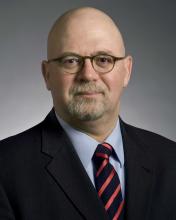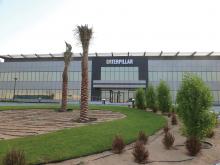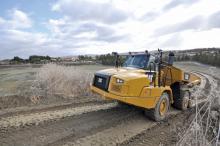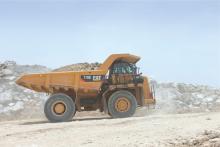Paolo Fellin, vice president of Caterpillar’s Global Construction & Infrastructure Division, has touched on the importance of the new dominance of booming African and other Emergent nation construction markets. Guy Woodford reports For Paolo Fellin, the last 10 years have seen the birth of a new order in world construction equipment sales.
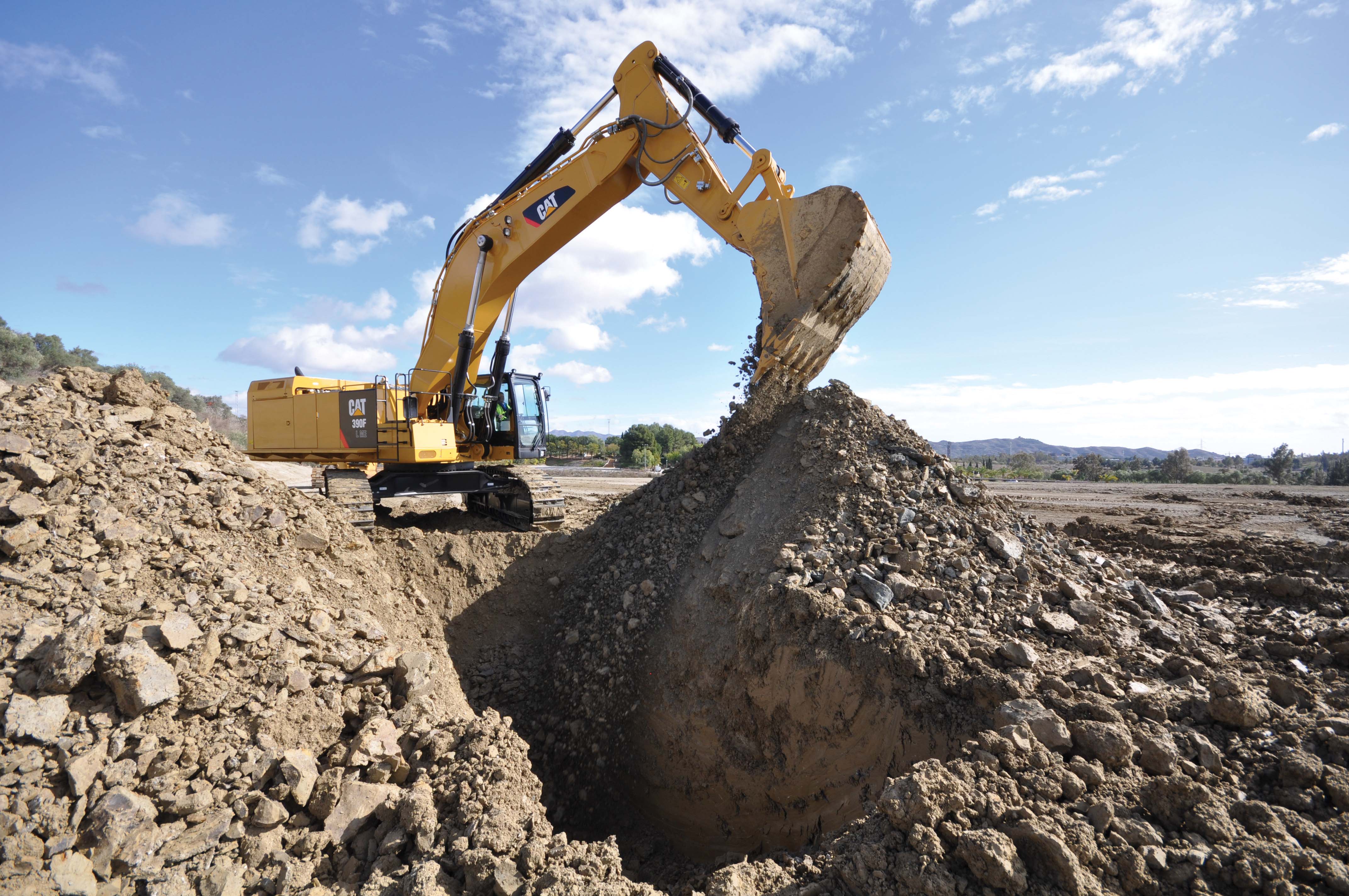
Caterpillar’s new 390F excavator in action at the Cat Malaga Demonstration Centre
Paolo Fellin, vice president of Caterpillar’s Global Construction & Infrastructure Division, has touched on the importance of the new dominance of booming African and other Emergent nation construction markets. Guy Woodford reports
For Paolo Fellin, the last 10 years have seen the birth of a new order in world construction equipment sales.
Speaking during the178 Caterpillar Press Day event showcasing the US construction equipment giant’s new machines range at the company’s Demonstration Centre in Malaga, Spain, the Caterpillar VP of Global Construction & Infrastructure said, “I remember about ten years’ ago in the EMEA [Europe, Middle East and Africa] Division alone, about 30% of our business came from Africa, the Middle East and Russia, and about 70% came from Europe. Right now, that thing has flipped completely.
“Obviously you can’t take a machine that is designed for Europe and just adapt it and throw it up somewhere else. Now we are building machines separately for the higher regulated countries, and for the less regulated countries. The customer often needs very high productivity and a certain type of machine. But a customer that has very low hours in one year needs less productivity and a different type of machine.” As an example of CAT’s different machine models of the same type for contrasting markets and applications, Fellin mentioned the F Series large wheeled excavators, the new M Series medium wheeled loaders and H Series small wheeled loaders.
He continued, “Segmentation is very important right now. One machine used to go everywhere. Now we have to build one machine out of one factory for the developed world, and another machine for other segments of the world.”
Fellin made his statistical illustration of the new dominance of emergent markets, such as Africa, of overall global construction equipment sales, while giving a general overview to the world’s construction equipment media of the state of key regional sales markets and Caterpillar’s focus on driving up customer profits through their use of CAT machines, equipment and services.
New 2013 trading figures showed that Caterpillar recorded US$55.656 billion sales revenues in the year – down 16% on the $65.875 billion posted in 2012. The drop was primarily said to be due to a Sharp decline in new machine sales for mining. The latest available full-year CAT EMEA ‘Construction Industries’ sales revenue figures, for the year 2012, saw the company achieve $4.633 billion annual sales revenues, compared to $4.768 billion in 2011.
The Caterpillar Press Day event saw the showcasing of a wide variety of new machine models including CAT’s 725C and 730C articulated trucks; the 772G off-highway truck; the 982M and 972M medium wheeled loaders; the 390F large excavator; and the 259D compact track loader.
Fellin’s views on the construction equipment purchasing power of the emergent markets mirrors the views of other senior figures in leading international construction equipment manufacturing companies.
In an article for World Highways prior to Bauma 2013 Mario Gasparri, head of the CNH Construction Equipment business for its Europe, Middle East, Africa (EMEA) business region said Africa and Middle East markets were growing much faster than other key regional markets such as Europe.
“In the Middle East, the oil and gas industry and road projects are the main construction drivers, and we expect Total industry volumes to continue growing, both in the light and heavy equipment,” said Gasparri.
“We expect the industry to grow in South Africa, where the government presented a package of strategic projects over the next 15 years.”
Independent market analysers share Fellin and Gasparri's focus on Africa and other emerging markets. Despite noting the “extremely tentative” mood of construction sector firms in the current economic climate,4137 KPMG’s Global Construction Survey 2013, published in October last year, states Africa is the region that attracts most business interest.
Meanwhile,1391 PricewaterhouseCoopers (PwC), the multinational professional services company, notes in its December 2013 report on South African construction that there are a number of “encouraging signs” that the national construction industry has sprung to life. These are said by PwC to stem from the financial performance of some of South Africa’s leading construction firms, their order book growth and public infrastructure commitments.
For Paolo Fellin, the last 10 years have seen the birth of a new order in world construction equipment sales.
Speaking during the
“Obviously you can’t take a machine that is designed for Europe and just adapt it and throw it up somewhere else. Now we are building machines separately for the higher regulated countries, and for the less regulated countries. The customer often needs very high productivity and a certain type of machine. But a customer that has very low hours in one year needs less productivity and a different type of machine.” As an example of CAT’s different machine models of the same type for contrasting markets and applications, Fellin mentioned the F Series large wheeled excavators, the new M Series medium wheeled loaders and H Series small wheeled loaders.
He continued, “Segmentation is very important right now. One machine used to go everywhere. Now we have to build one machine out of one factory for the developed world, and another machine for other segments of the world.”
Fellin made his statistical illustration of the new dominance of emergent markets, such as Africa, of overall global construction equipment sales, while giving a general overview to the world’s construction equipment media of the state of key regional sales markets and Caterpillar’s focus on driving up customer profits through their use of CAT machines, equipment and services.
New 2013 trading figures showed that Caterpillar recorded US$55.656 billion sales revenues in the year – down 16% on the $65.875 billion posted in 2012. The drop was primarily said to be due to a Sharp decline in new machine sales for mining. The latest available full-year CAT EMEA ‘Construction Industries’ sales revenue figures, for the year 2012, saw the company achieve $4.633 billion annual sales revenues, compared to $4.768 billion in 2011.
The Caterpillar Press Day event saw the showcasing of a wide variety of new machine models including CAT’s 725C and 730C articulated trucks; the 772G off-highway truck; the 982M and 972M medium wheeled loaders; the 390F large excavator; and the 259D compact track loader.
Fellin’s views on the construction equipment purchasing power of the emergent markets mirrors the views of other senior figures in leading international construction equipment manufacturing companies.
In an article for World Highways prior to Bauma 2013 Mario Gasparri, head of the CNH Construction Equipment business for its Europe, Middle East, Africa (EMEA) business region said Africa and Middle East markets were growing much faster than other key regional markets such as Europe.
“In the Middle East, the oil and gas industry and road projects are the main construction drivers, and we expect Total industry volumes to continue growing, both in the light and heavy equipment,” said Gasparri.
“We expect the industry to grow in South Africa, where the government presented a package of strategic projects over the next 15 years.”
Independent market analysers share Fellin and Gasparri's focus on Africa and other emerging markets. Despite noting the “extremely tentative” mood of construction sector firms in the current economic climate,
Meanwhile,

